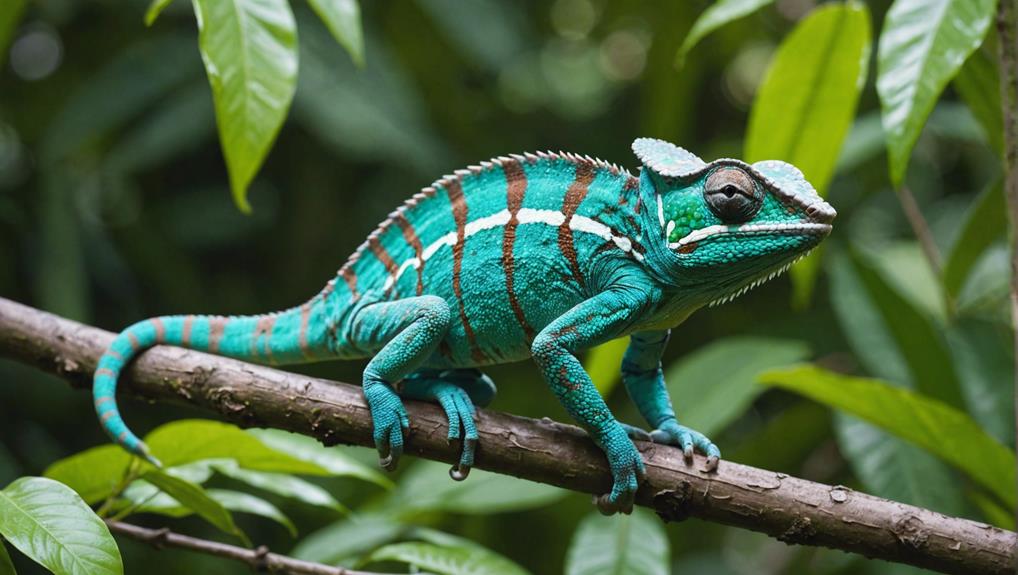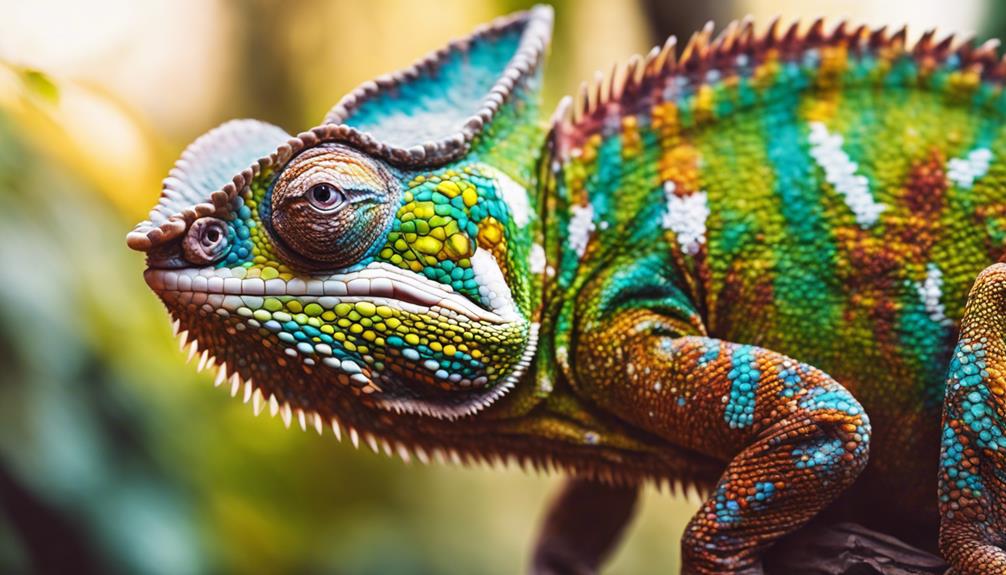Get ready to be mesmerized by the vibrant world of Parson's chameleons, where color changes are a way of life.
Native to Madagascar's rainforests, these impressive creatures thrive in the humid, dense foliage. Males can reach up to 27 inches in length, and their vibrant color shifts help regulate their temperature and communicate with others.
With expert camouflage and long tongues, they expertly hunt insects.
Females lay up to 50 eggs, which incubate for 18-24 months. Unfortunately, habitat loss and the pet trade threaten their existence.
Conservation efforts focus on preserving their habitat and regulating trade to protect these fascinating creatures.
Discover the intriguing lives of Parson's chameleons and the efforts to safeguard their future.
Habitat and Distribution
Parson's chameleon thrives in the lush rainforests of Madagascar. If you want to see these incredible creatures, you need to head to this unique island.
They play a vital ecological role by controlling insect populations, which helps maintain the delicate balance of the rainforest ecosystem. The chameleon's presence is a symbol to the rich biodiversity.
You'll often find Parson's chameleons in specific microhabitats within the forest. They prefer humid, dense foliage where they can blend in and hunt effectively.
Look for them in the lower to mid-canopy layers, where the temperature and humidity levels are just right for their needs. These chameleons are perfectly adapted to the environment, making the most of the resources available.
Their microhabitat preferences mean they're often found in undisturbed, primary forests. If you're exploring these areas, you might spot one clinging to a branch, its slow movements almost making it invisible.
This preference for pristine habitats also makes them indicators of forest health. If Parson's chameleons are thriving, the forest is likely in good condition.
Understanding their ecological role and microhabitat preferences is essential if you're interested in conservation. Protecting the rainforests of Madagascar not only safeguards these chameleons but also preserves the broader ecosystem they support.
Physical Characteristics
Parson's chameleons are renowned for their unique features, setting them apart from other chameleon species. One of the most noticeable aspects is their size. These chameleons are among the largest in the world, with males reaching lengths of up to 27 inches, while females are slightly smaller, typically growing to about 19 inches.
Their robust bodies and large heads give them a distinct, almost prehistoric appearance. You'll notice that their eyes are particularly striking, capable of independently rotating and focusing on different objects simultaneously. This gives them a 360-degree field of vision, allowing them to spot prey and predators with remarkable efficiency.
Another unique feature is their gripping, zygodactylous feet, which have two toes pointing forward and two pointing backward. This specialized structure helps them expertly navigate the trees and branches of their forest habitat. Their prehensile tails are also remarkable, acting like a fifth limb to provide extra stability and support while climbing.
Despite their impressive size variations, Parson's chameleons maintain a delicate balance of agility and strength. Their skin is covered in small, granular scales, which provide protection and help reduce water loss. Their large, fleshy tongues, which can extend up to twice the length of their bodies, are perfectly adapted for capturing insects and other small prey.
Color Changing Abilities
In addition to their impressive physical attributes, these chameleons captivate with their remarkable color-changing abilities. Parson's Chameleons don't just change color for camouflage; their transformations serve multiple purposes, including temperature regulation and stress response. When basking in the sun, they might turn a darker shade to absorb more heat. Conversely, when they need to cool down, they can adopt lighter hues to reflect sunlight.
The ability to change color is also a social tool. These chameleons communicate their mood and intentions through their vivid displays. For instance, a male might flaunt bright colors to attract a mate or exhibit darker shades when feeling threatened or stressed. This color-changing prowess allows them to stay in tune with their environment and peers.
Here's a simple table to help you visualize how their color changes correspond to different scenarios:
| Scenario | Color Change |
|---|---|
| Temperature Regulation | Darker shades to absorb heat |
| Temperature Regulation | Lighter shades to reflect sunlight |
| Stress Response | Darker shades when threatened |
| Social Interaction | Bright colors to attract a mate |
| Social Interaction | Subtle shifts to communicate state |
Their skin contains specialized cells called chromatophores, which house various pigments. By expanding or contracting these cells, they create different colors and patterns. These shifts are not just surface-level; they reflect the chameleon's internal state and external conditions.
Understanding these mechanisms can deepen your appreciation for the Parson's Chameleon. Their color-changing abilities aren't just a spectacle—they're a sophisticated means of survival and communication. Whether they're regulating their body temperature or responding to stress, these chameleons are masters of adaptation, making them truly fascinating creatures to observe.
Diet and Hunting
When it comes to their diet, these chameleons primarily feast on insects and other small invertebrates. Parson's Chameleons have a diverse palate, showing a preference for prey like crickets, locusts, and katydids. They're also known to enjoy snacking on beetles, grasshoppers, and occasionally, small birds or mammals.
Their prey preferences reflect their opportunistic feeding style, allowing them to thrive in their natural habitat.
You'll find that Parson's Chameleons have some of the most fascinating feeding techniques. They possess a specialized tongue that can extend to twice the length of their body, allowing them to capture prey with incredible precision. This tongue isn't only long but also fast, reaching speeds that rival the blink of an eye.
They use this rapid-fire mechanism to snatch up unsuspecting insects, ensuring a quick and efficient meal.
Their hunting strategy is a blend of patience and stealth. Parson's Chameleons rely heavily on their excellent camouflage to blend into their surroundings, making it easier to ambush prey. They remain still for long periods, waiting for the right moment to strike.
When they spot a potential meal, they slowly move closer, carefully positioning themselves before launching their sticky tongue to grab the prey.
Observing a Parson's Chameleon hunt is like watching a master at work. Their ability to remain unnoticed until the perfect moment is a demonstration of their evolutionary adaptations. By understanding their diet and hunting techniques, you gain insight into the intricate balance of nature that supports their survival.
You'll see that every tiny detail plays a vital role in their daily quest for sustenance.
Reproduction and Lifespan
When discussing the reproduction and lifespan of Parson's chameleon, you'll notice their unique mating season behaviors and the intricate egg-laying process.
Female chameleons can lay up to 50 eggs, which then require about 18 months to hatch.
In captivity, these chameleons often live between 5 to 9 years, depending on their care.
Mating Season Behavior
Parson's chameleons exhibit fascinating courtship behaviors during their mating season, marked by vibrant color changes and intricate displays. Males become territorial and often engage in disputes to establish dominance. You'll notice them puffing up their bodies and displaying brilliant hues to attract females and ward off rivals. These courtship rituals are a striking spectacle, showcasing their elaborate color transformations and body language.
Once a male successfully claims his territory, he approaches a female with a series of gentle head bobs and sways. If the female is receptive, she will turn her body towards him, allowing mating to occur. The entire process is a delicate dance, filled with visual cues and subtle movements.
Here's a quick look at the typical behaviors during the mating season:
| Behavior | Male Actions | Female Responses |
|---|---|---|
| Territory Disputes | Puffing up, color changes, combat | Avoidance or submission |
| Courtship Rituals | Head bobs, body sways, vibrant hues | Turning towards or away |
| Mating Approach | Gentle advances | Receptive posture or retreat |
| Color Displays | Bright, changing colors | Neutral or complementary colors |
| Post-Mating | Guarding territory | Seeking nesting sites |
Understanding these behaviors allows you to appreciate the complex and colorful world of Parson's chameleons even more.
Egg Laying Process
After the intricate courtship rituals, the female chameleon undertakes the critical task of finding a suitable nesting site to lay her eggs. This process is both fascinating and essential for the survival of Parson's chameleons. The female meticulously searches for the perfect spot, usually a well-drained, sandy area where she can dig a hole to deposit her eggs.
Once she's satisfied with her nest selection, she digs a hole that can be up to a foot deep. She lays her eggs, which can number anywhere from 20 to 50. After laying, she carefully covers the eggs with soil, camouflaging the nest to protect it from potential predators.
Embryo development is a lengthy process for Parson's chameleons. The eggs incubate in the ground for about 18 to 24 months before the tiny chameleons hatch. During this period, the embryos develop slowly, relying on the temperature and humidity of their environment to thrive.
This extended incubation period is pivotal for the proper development of the young chameleons. Once they hatch, they're ready to set out on their own journey, continuing the cycle of life for these remarkable reptiles.
Lifespan in Captivity
In captivity, Parson's chameleons can live up to 8-10 years, provided they receive proper care and a suitable environment.
To promote your chameleon's well-being, start with a well-designed enclosure. It should be spacious with plenty of vertical space since these creatures love to climb. Include natural branches, vines, and plants to mimic their natural habitat, which helps reduce stress and promote natural behavior.
Health monitoring is vital. Regularly check for signs of illness such as changes in appetite, color, or behavior. A balanced diet rich in vitamins and minerals is essential for their longevity. Supplement their diet with calcium and vitamin D3 to prevent metabolic bone disease. Clean the enclosure frequently to prevent bacterial build-up, and maintain proper humidity and temperature levels.
Breeding in captivity requires attention to detail. Females need a suitable laying substrate and proper nutrition to support egg production. After laying, eggs require specific incubation conditions for successful hatching. Monitor the developmental stages closely.
Conservation Status
Parson's Chameleons need our help because they're facing threats like habitat loss and illegal pet trade, which put their survival at risk.
Conservation efforts and habitat protection strategies can make a difference for these incredible creatures.
Threats to Survival
Parson's Chameleons face significant threats to their survival due to habitat destruction and illegal wildlife trade.
The deforestation impact is massive, as these chameleons are native to Madagascar, where logging and agricultural expansion are rapidly depleting their natural habitat. When forests are cleared, these creatures lose their homes and food sources, making it difficult for them to survive.
The pet trade also poses a significant danger. Parson's Chameleons are often captured and sold illegally because of their unique colors and large size. This not only reduces their wild populations but also subjects them to stressful and often deadly conditions during capture and transport.
You might think owning one is exotic and freeing, but it contributes to their decline.
In the wild, these chameleons play a vital role in their ecosystem, controlling insect populations and maintaining biodiversity. When their numbers dwindle, it disrupts these natural processes.
In addition, their slow reproductive rate makes it hard for their populations to recover from these pressures quickly.
Understanding these threats can help you advocate for their protection and appreciate the delicate balance of natural habitats.
Let's safeguard these incredible creatures continue to thrive in the wild.
Conservation Efforts
Efforts to conserve Parson's Chameleons often focus on protecting their natural habitats and curbing illegal trade. You can play a pivotal role in these efforts by supporting initiatives that aim to safeguard these fascinating creatures.
One effective approach is to raise awareness through education programs, which help people understand the importance of preserving chameleons and their ecosystems. These programs often highlight the threats Parson's Chameleons face and provide practical steps for conservation.
Community outreach is another essential component. By engaging local communities, you can foster a sense of responsibility and encourage sustainable practices that benefit both the chameleons and the people living nearby. Collaborative projects can lead to long-term positive impacts on the species' survival.
To get involved:
- Supporting conservation organizations: Many groups work tirelessly to protect Parson's Chameleons. Your donations or volunteer efforts can make a significant difference.
- Participating in local events: Educational workshops, talks, and community activities can enhance public understanding and support for conservation.
- Advocating for stronger laws: Pushing for stricter regulations on illegal trade and habitat destruction is essential for protecting these chameleons.
Habitat Protection Strategies
Protecting the natural habitats of Parson's Chameleons is vital to their survival and involves implementing effective conservation strategies. To facilitate these colorful creatures' thriving, you need to focus on both community involvement and legislative measures. Engaging local communities in conservation efforts can make a significant impact. When people understand the importance of Parson's Chameleons, they're more likely to support habitat protection initiatives.
Here's a breakdown of some key strategies:
| Strategy | Description |
|---|---|
| Community Involvement | Educate and engage locals to participate in conservation. |
| Legislative Measures | Enact laws to protect critical habitats from deforestation. |
| Sustainable Practices | Promote eco-friendly practices to preserve natural ecosystems. |
Effective conservation starts with education. By raising awareness about the chameleon's plight, you empower people to act. Community involvement can range from local workshops to participatory reforestation projects.
Legislative measures, on the other hand, create a legal framework for protection. Laws can restrict logging activities and safeguard essential habitats.
Lastly, promoting sustainable practices guarantees that the ecosystems remain viable. Encourage responsible land use and support eco-tourism, which benefits both the environment and local economies. By combining these strategies, you can help create a safer world for Parson's Chameleons.
Conclusion
By exploring the habitat, physical characteristics, color-changing abilities, diet, hunting methods, reproduction, and conservation status of the Parson's chameleon, you've gained a thorough understanding of this fascinating reptile.
These chameleons are remarkable creatures, known for their vibrant colors and unique behaviors.
Protecting their natural habitats is vital for their survival.
As you continue to learn about wildlife, remember the importance of conservation and the role you can play in preserving these incredible species.


